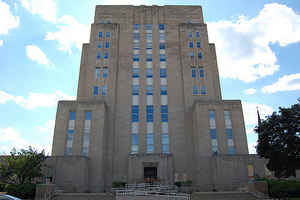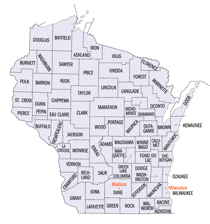Wisconsin Counties
There are seventy-two counties in the state of Wisconsin. Wisconsin became part of the Territory of Michigan and divided into two counties: Brown County in the northeast along Lake Michigan and Crawford County in the southwest along the Mississippi River. The state of Wisconsin was created from Wisconsin Territory on May 29, 1848, with 28 counties.Racine County, Wisconsin
Racine County Education, Geography, and History

Racine County is a county located in the State of Wisconsin. Based on the 2010 census, the population was 195,408, making it the fifth-most
populous county in Wisconsin. Its county seat is Racine.
Racine County comprises the Racine, WI Metropolitan Statistical Area and is included in the Milwaukee-Racine-Waukesha, WI Combined Statistical
Area.
Etymology - Origin of Racine County Name
Named for its principal town, which was laid off in 1834-35 by Gilbert Knapp. The first designation of this settlement was Port Gilbert; but its founder decided to change this to Racine, the French translation of Root River, on which he had laid out his town. Root was apparently the translation of the aboriginal name for this stream - see Wis. Hist. Colls., vii, pp. 335, 341; Butterfield, History of Racine and Kenosha Counties (Chicago, 1879), pp. 279, 355.
[Source: Kellogg, Louise Phelps. "Derivation of County Names" in Proceedings of the State Historical Society of Wisconsin for 1909, pages 219-231.]
Demographics:
County QuickFacts: CensusBureau Quick Facts
County History
Woodland Indians were the earliest known inhabitants of Racine County. In the latter half of the 17th Century,
French fur traders and missionaries, including Nicholas Perrot and Fathers Claude Allouez and Jacques Marquette,
found predominately Miami Indians inhabiting the lands along Racine's Root River.
By 1720, the Miami tribe had moved on and the area had become the home of the Potawatomi Indians. In the late
1820's, at a place then called Skunk Grove, Jacques and Louis Vieaux set up a fur trading post with the Potawatomi.
A historic marker has been placed at the site, which is now in the Town of Mount Pleasant.
Following the Black Hawk War in 1832, "Wisconsin Fever" brought many pioneers from Western New York State, rural New
England and Britain to this area. One of these was Captain Gilbert Knapp, who, in 1834, founded the settlement of
Port Gilbert at the place where the Root River empties into Lake Michigan. However, the name Port Gilbert never
gained acceptance over the earlier Indian designation of Chippecotton (Root River) or its French version, Racine,
and in 1841 the community was incorporated as the Village of Racine. Shortly after statehood was granted in 1848,
the brand new Wisconsin legislature voted to incorporate the Village of 3,000 as the City of Racine.
Soon after Captain Knapp founded his settlement on Lake Michigan, other pioneers were settling areas to the west.
Lemuel Smith, who arrived in 1835, was said to have been the first settler in Burlington. David Bushnell and Herman
and Elizabeth Loomis arrived the following year. In 1836, Levi Godfrey and John Wade built a log house in what is
now Rochester. S.E. Chapman and Levi Barnes came to Waterford the same year.
In 1805, Congress created the Michigan Territory, which included all the land that is now in the State of Wisconsin.
In 1818, the land west of Lake Michigan was divided into three counties. As settlers moved in, new Counties were
split off from those original three. Milwaukee County was founded in 1834, the year Captain Knapp arrived, and
included all the land along the lake south to Illinois. In 1836, the Wisconsin Territory was organized. That same
year, this area was sufficiently inhabited to warrant separation from Milwaukee County, and Racine County was
formed. It did not take on its present-day borders, however, until 1850, when Kenosha County was created out of its
southernmost portion.
In the years preceding the Civil War, Racine was known for its strong opposition to slavery. Many slaves escaping to
freedom via the "underground railroad" passed through Racine County. When Joshua Glover, an escaped slave who had
made a home in Racine, was arrested as a fugitive and taken to jail in Milwaukee, a band of citizens from Racine
broke into the jail and freed him.
When the Civil War began, the men of Racine County responded by forming the "Belle City Rifles." Over the course of
that conflict, more than 2,000 of Racine County's sons fought in the Union Army. Almost 275 were killed, including
Colonel Hans Christian Heg, one of the founders of the Town of Norway and the highest-ranking officer from the State
of Wisconsin to perish in the War. A statue honoring him is located in the County's Heg Park.
Racine County holds the distinction of having erected, in 1853, the first High School building in the State of
Wisconsin. The present County Courthouse grounds include the former sites of both Racine High School and the
County's first public school.
Racine County land has been farmed for 2,000 years. The first Racine County farmers, members of the Hopewell Culture
that inhabited the area some 1,300 to 1,900 years ago, grew corn, beans, squash and tobacco. Later, the Potawatomi
added melons and pumpkins, and introduced the harvesting of maple sap and sugar.
The primary crop for the first European settlers was wheat. The Perkins flouring mill of Burlington sent the first
Wisconsin wheat back east in the 1840's. After the Civil War, however, dairy farming became more important, and
remains so today. In 1998, there were 650 farms, covering 136,000 acres, in Racine County.
The first industry in Racine County was agriculture-related, and included the manufacture of fanning mills, machines
that separated grain from chaff. In 1842, 24-year old Jerome Increase Case came from New York State with a combined
thresher-separator that he had invented. He started production of his machine in Rochester, in competition with a
local company, Fanning Mills. Case moved his factory to the City of Racine a few years later. The company he
founded, originally J.I. Case but now CNH, is still headquartered in Racine and continues to be a world leader in
the manufacture and sale of agricultural and construction equipment.
As dairy farming became more prevalent, it brought other industries. Wagner Specialty Company of Burlington produced
bull rings and calf weaners for use by farmers. In the years following the Civil War, the Horlick Malted Milk
Company of Racine sold the powdered milk and malted milk that British immigrant William Horlick developed. The
Wisconsin Condensed Milk Company was active in Burlington.
Racine County has long been known for the inventiveness of its citizens. In 1873, Reverend J.W. Carhart put together
one of the first steam-powered automobiles. J.I. Case and Mitchell & Lewis were among a group of Racine-based car
manufacturers in the late 19th and early 20th centuries.
The car companies spurred the establishment of other businesses that provided vehicle parts, including Walker
Manufacturing Company (jacks and mufflers), Twin Disc (clutches) and Modine Manufacturing Company (heat transfer
products and torque converters). These firms endure even though no cars have been manufactured in Racine County for
years.
During this same time period, S.C. Johnson founded a company to manufacture and distribute floor wax products. That
enterprise has grown into one of the largest manufacturers of personal, household and professional cleaning products
and insect control products in the world, now known as S.C. Johnson, A Family Company.
These years also saw the growth of Western Publishing Company. When a small printing business came under the control
of the Wadewitz family of Racine, it blossomed into a large firm well known throughout the world for publishing
"Little Golden Books."
Description from John W. Hunt's 1853 Wisconsin Gazetteer: "RACINE, County, is bounded on the north by Waukesha and Milwaukee, on the east by the State line in Lake Michigan, on the south by Kenoshia, and on the west by Walworth. It was organized from the limits of Milwaukee Dec. 7, 1836. The seat of justice is at the city of Racine, on the lake shore. This county has a proper proportion of prairie and timber, and is well adapted to agriculture. Its productions are various. Besides other branches of agriculture, the raising of fruit and keeping of cattle and sheep are successfully carried on. There is also a large amount of capital profitably employed in various branches of manufacture. A large portion of the county is well settled and improved. Though small in extent, it possesses advantages unsurpassed by any county in the State. Its soil is well adapted to all the products of the climate, and being contiguous to the lake, it has good and convenient markets both at Racine and other lake ports. Its principal streams are O'Plaine and Root rivers.
RACINE.--Population 20, 667.
From: Handbook of Wisconsin by S. Silas, 1855
pg. 96-97
Is one of the small, and old settled counties, lying in the south-eastern part of the State, and one of the most
densely populated. It is prairie interspersed with openings, with some heavy timber in the northern part. It is
gently undulating in surface, and well watered. All the public lands are taken up. The County is improved and highly
cultivated, and the farms of Racine will bear comparison with those in any other part of the State. It is a good
grazing and stock growing County.
Racine is the County Seat, and the Lake port, beautifully located at the mouth of Root River, which the enterprise
of its citizens have converted into a good harbor. The Racine Rail Road passes into the country west to Beloit, and
is now running about 20 miles. The Lake Shore Rail Road also passes through Racine. A plank road also reaches back
to Delevan. Racine College, under the care of the Episcopal Church, is located here. Population of the city 8044.
Geography: Land and Water
As reported by the Census Bureau, the county has a total area of 792 square miles (2,051 km2), of which, 333 square miles (863 km2) of it is land and 459 square miles (1,188 km2) of it (57.94%) is water.
Neighboring Counties
Bordering counties are as follows:
- Milwaukee County (north)
- Lake Michigan (east)
- Kenosha County (south)
- Walworth County (west)
- Waukesha County (north)
Education







